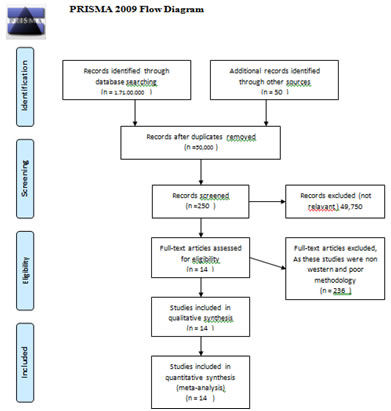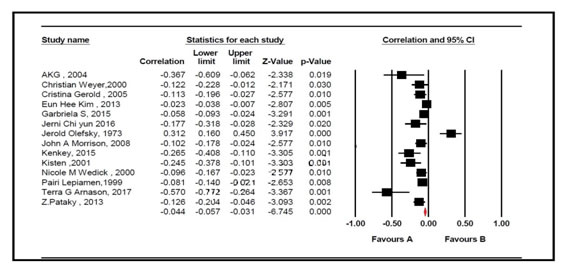Official Journals By StatPerson Publication
|
Table of Content - Volume 5 Issue 1 - January 2018
Fasting insulin predicts an insulin resistance: A meta analysis using western countries data
Kavindra Borgaonkar1*, Ranjit Patil2, Pradeep Benjarge3
1Associate Professor, Department of Biochemistry, Government Medical College, Latur Maharashtra INDIA. 2Professor Department Of Medical Biochemistry Ssr Medical College Belle Rive, MAURITIUS. 3Consultant Physician Krishna Hospital Aurangabad Maharashtra, INDIA. Email: kb2172@rediffmail.com, ranj42@gmail.com, pradeep777@gmail.com
Abstract Background: The American Diabetes Association included hemoglobin A1c (HbA1c) as adiagnostic test for diabetes in their 2010 clinical practice recommendations Aims and Objectives: To study Fasting insulin and insulin resistance in a meta analysis using western countries data. Methodology: This meta-analysis involves non diabetic individual with fasting insulin level in western population form 44 years i.e. 1973 to 2017 published studies related to western world. In total 23222 population was studied; for selecting these article various search engines like PubMed, Medline, Mendlay Library, Cochrane Library, Embase search, Google Scholar, Index Copernicus, Science Direct with key words Hyperinsulinemia, Syndrome X, Type II Diabetes. Statistical analysis done by Comprehensive Metanalysis software. Result: There was statistically significant co-relation between Fasting plasma insulin level and insulin resistance in the western population the overall fixed effect result of our study was with co-relation of (95% CI) was -0.044 (-0.057 to -0.031) with Z=-6.74, p<0.000 Conclusion: It can be concluded from our study that there was statistically significant co-relation between Fasting plasma insulin level and insulin resistance in the western population so this criteria can be used to diagnose insulin resistance and early diagnosis of insulin resistance. Key Words: Insulin resistance, Hyperinsulinemia, Syndrome X, Type II Diabetes.
The American Diabetes Association included hemoglobin A1c (HbA1c) as a diagnostic test for diabetes in their 2010 clinical practice recommendations1. In addition to being tightly associated with diabetes, HbA1c predicts cardiovascular events among non-diabetic individuals and it may outperform fasting plasma glucose for predicting cardiovascular disease2. In contrast, serum insulin measurement is not used as often, despite the fact that it can identify insulinresistant subjects, which is a strong marker of future diabetes3. The metabolic syndrome defines a group of cardiovascular risk factors that appear together and are strongly associated with the development of ischemic heart disease and diabetes4. The metabolic syndrome is tightly linked to insulin resistance5, which is considered one of its essential characteristics and it was initially required for diagnosis of the syndrome6. Still, the clinical criteria that are currently used for diagnosis face numerous limitations7 so we are considering this could be beneficial component for the early diagnosis of insulin resistance. Berson and Yalow8 defined insulin resistance (IR) as a state (of a cell, tissue, system, or body) in which greater than normal amount of insulin is required to elicit a quantitatively normal response. Insulin is a key regulator of glucose homeostasis and insulin resistance is determined by both genetic and environmental factors and plays an important pathophysiological role in diabetes.9 The abnormalities initially associated with insulin resistance in nondiabetic individuals included hyperinsulinemia, borderline glucose tolerance, dyslipidemia (in the form of increased triglycerides and decreased HDL cholesterol) and hypertension.10 so this metanalysis was done with aim of asses correlation between fating insulin level and insulin resistance in the western population.
MATERIAL AND METHODS This meta-analysis study involves non diabetic individual with fasting insulin level in western population form 44 years i.e. 1973 to 2017 published studies involving the western world. In total 23222 population was studied ; for selecting these article various search engines like PubMed, Medline, Mendlay Library, Cochrane Library, Embasesearch, Google Scholar, Index Copernicus, Science Direct etc. to study the Articles with Key Words like insulin resistance, Hyperinsulinemia, Syndrome X, Type II Diabetes in Western Population there was 1,71,00,000 articles were there by using various filters like insulin resistance Western Population there was near about 250 studies were there in the study period again these 250 studies was studied by a Team of Expert for the inclusion and exclusion of studies at the end 14 studied selected 11-24 Into the study, statistical analysis done by Comprehensive Metanalysis software. The flow chart as per the PRISMA 2009 guideline is as follows.
RESULT From below table of Meta analysis it is clear that there was statistically significant co-relation between Fasting plasma insulin level and insulin resistance in the western population the over all fixed effect result of our study was with co-relation of (95% CI) was -0.044 (-0.057 to -0.031) with Z=-6.74, P<0.000
Table 1: Metanalysis Showing the correlation of Fasting insulin and Insulin resistance
DISCUSSION Fasting insulin is one of the most commonly studied surrogate marker of insulin resistance. Yeni - Komshian et al25 studied 490 healthy non-diabetic volunteers. They derived steady state plasma glucose (SSPG) from insulin suppression test and correlated it with various surrogate measures. They reported significant correlations of SSPG with fasting insulin, 120 min insulin, insulin area under the curve, fasting glucose/ insulin ratio and HOMA-IR. Although they described total insulin response during an OGTT as the best surrogate measure, they also suggested that determination of fasting insulin can provide a qualitative estimate of insulin resistance. Similarly Markku Laakso26 measured insulin response to an oral glucose load and quantitated insulin resistance using the euglycemic hyperinsulinemic clamp technique to evaluate the correlation between fasting and postprandial insulin levels, and the degree of insulin resistance in individuals with varying degrees of glucose tolerance They reported that although correlations of direct estimates of insulin resistance with fasting or post-glucose load insulin levels were consistent in subjects with normoglycemia, in subjects with impaired glucose tolerance and diabetes, only the fasting insulin correlated significantly with insulin resistance. They suggested that in population studies, only the fasting insulin level should be used as a marker of insulin resistance. Similarly Hanson RL et al27 achieved high degree of correlation of fasting and post-glucose load insulin with direct measure of insulin resistance as determined by hyperinsulinemia euglycemic clamp. They reported that although correlations of direct estimates of insulin resistance with fasting or post-glucose load insulin levels were consistent in subjects with normoglycemia, in subjects with impaired glucose tolerance and diabetes, only the fasting insulin correlated significantly with insulin resistance. They suggested that in population studies, only the fasting insulin level should be used as a marker of insulin resistance. Similarly Hanson RL et al27 achieved high degree of correlation of fasting and post-glucose load insulin with direct measure of insulin resistance as determined by hyperinsulinemia euglycemic clamp. In our study there was statistically significant co-relation between Fasting plasma insulin level and insulin resistance in the western population the overall fixed effect result of our study was with co-relation of (95% CI) was -0.044 (-0.057 to -0.031) with Z=-6.74, P<0.000 except in the study by Jerrold Olefsky all other studies shown the negative co-relation of Fasting insulin and insulin resistance syndrome the difference in the study may be because in the prediabetic individual reacts with complex mechanism of insulin secretion in the fasting either hyperinsulinemia or hyperinsulinemia probably this complex mechanism might be responsible in their study.
CONCLUSION It can be concluded from our study that there was statistically significant co-relation between Fasting plasma insulin level and insulin resistance in the western population so this criteria can be used to diagnose insulin resistance and early diagnosis of insulin resistance.
REFERENCES
|
 Home
Home


